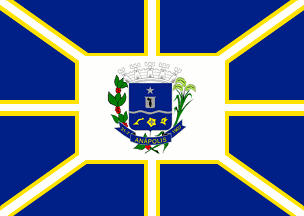 image by Dirk Schönberger, 8 April
2010
image by Dirk Schönberger, 8 April
2010
Last modified: 2012-02-10 by ian macdonald
Keywords: anápolis | goiás |
Links: FOTW homepage |
search |
disclaimer and copyright |
write us |
mirrors
 image by Dirk Schönberger, 8 April
2010
image by Dirk Schönberger, 8 April
2010
based on http://pt.wikipedia.org/wiki/Anápolis
A dark blue field with 8 yellow-fimbriated white stripes, four diagonal, four upright; in center a yellow-bordered white rectangle bearing the municipal arms.
Municipal web site:
http://www.anapolis.go.gov.br/
Dirk Schönberger, 8 April 2010
The municipality of Anápolis (334,613 inhabitants, therefore the 3rd most
populous municipality in the State; 918 sq. km) is located in central Goiás,
50 km of Goiânia.
Anápolis (lit., Ann's Town) is protected by St. Ann.
The tradition says that Ana das Dores de Almeida, when traveling through the
region, lost one of her mules carrying a holy image of St. Ann. Found back,
the mule refused to move ahead, which was interpreted by Ana as St. Ann's
wish to have a sanctuary built there. Ana's son, Gomes de Sousa Ramos
(1837-1890), fulfilled his mother's promise 11 years later, building in 1871
a chapel dedicated to the saint. The holy image of St. Ann is still preserved
and venerated in Anápolis. The hamlet of Santana das Antas, named for her
patron saint and the neighboring river, developed around the chapel. Gomes de
Sousa Ramos and the other local hero, Colonel José de Silva "Zeca" Batista
(1856-1910) struggled for the political emancipation of the place. Santana
das Antas was granted the status of "vila" by Law No. 811 of 15 December
1887; presided by Zeca Batista, the new government of the village was
inaugurated on 10 March 1892. Subsequently made a "cidade", Santana das Antas
was renamed Anápolis by Decree of 31 July 1907, this day being considered as
the day of foundation of the town.
The coat of arms of Anápolis is
prescribed by Law No. 59 of 31 January 1967.
"Samnitic shield ensigned
with an eight-towered mural crown argent. On a field azure, in chief a
five-pointed star argent, an escutcheon argent charged with a matriarchal 'fuso',
a fess dimidiated wavy argent, in base, per fess a plough, a wheel and a
Mercury's helmet, all or. The shield supported dexter by a branch of coffee
fructed proper and sinister by a plant of rice crossed per saltire under the
shield, over a scroll azure charged with the writing argent* 'Anápolis' and
the date '31-7-1907'.
*shown or on the drawings of the flag and arms
The Samnitic shield, introduced from France to Portugal, symbolizes the
Latin race as the main colonist and founder of the Brazilian nation. The
mural crown is the heraldic representation of power; its eight towers
represent a town of second rank. Azure is the heraldic symbol of justice,
beauty, sweetness, nobleness, recreation, perseverance, zeal and loyalty
(according to Ascêncio). The star, a symbol of celebrity according to
Ronchetti, recalls that Anápolis was the first town of significance in the
State. According to Guelfi, the star represents a safe guide, aspiration to
sublime acts etc. The escutcheon bears the heraldic representation of St.
Ann, placed in the heart and most noble point of the shield. Argent is the
heraldic symbol of friendship, equity, innocence and purity (Guelfi).
Sable (black) symbolizes prudence, wisdom, science, firmness, honesty,
moderation and simplicity (Ascêcio). The fess wavy argent represents river
Antas. The three charges placed in the base of the shield represent work,
industry and trade, respectively, representing the leadership of Anápolis in
these activities. Coffee and rice symbolize the local products of the
fertile soil. The scroll includes the name of the municipality and its date
of erection to a "cidade".
After "História de Anápolis" by Humberto
Crispim Borges
http://www.anapolis.go.gov.br/portal/anapolis/simbolos
- Municipal website
Ivan Sache, 23 January 2012